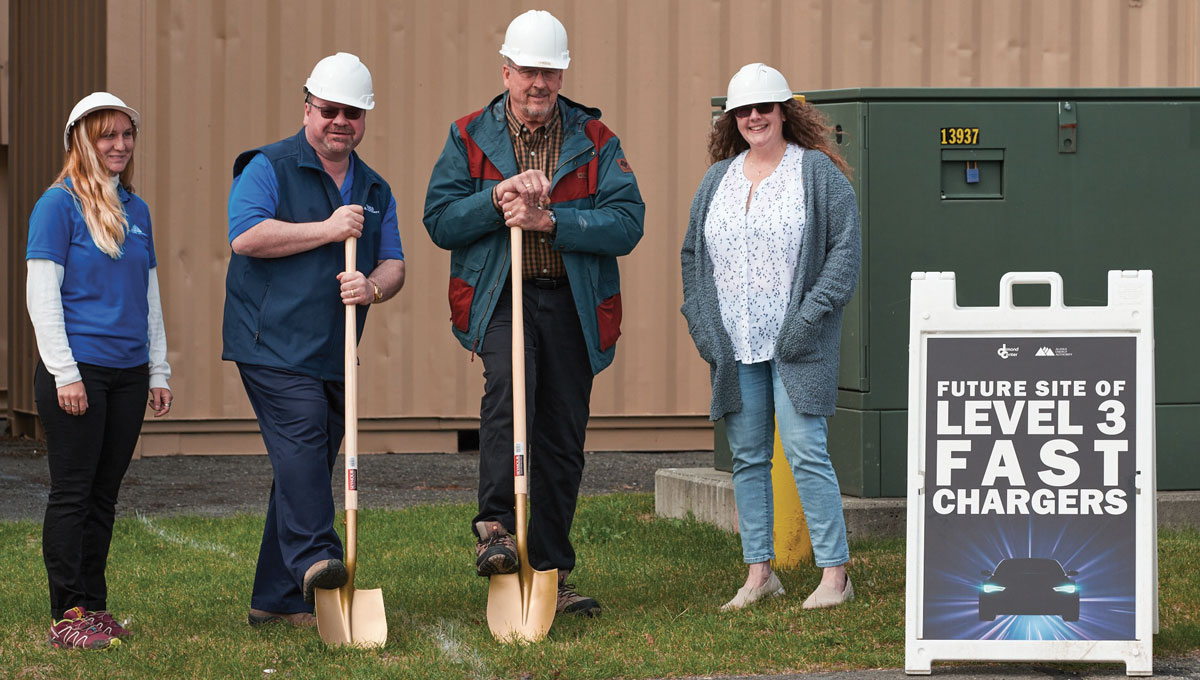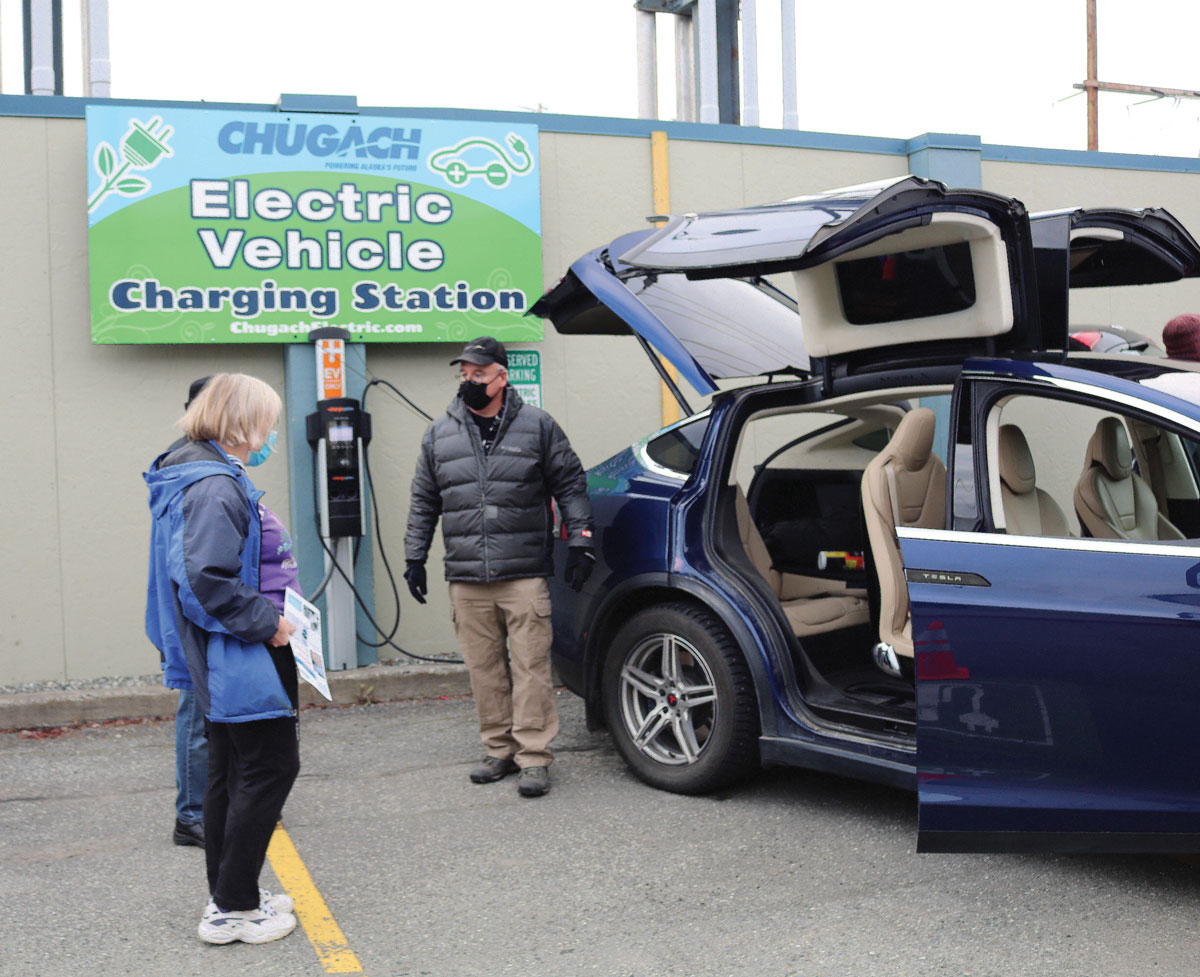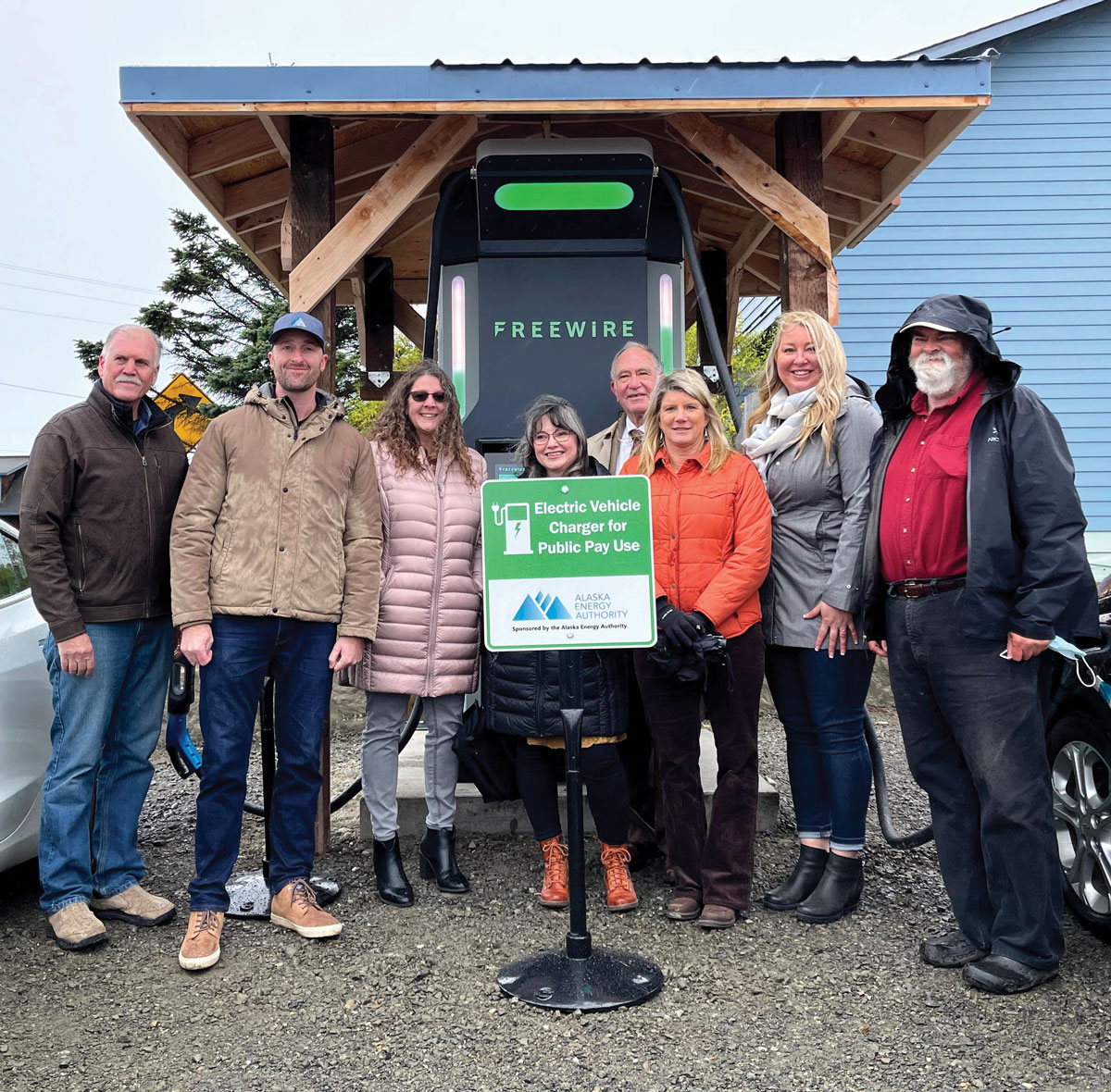ailpipes of idling cars and trucks exhale visible wisps on a chilly day. The clouds are mostly harmless water vapor. The invisible part, though, is carbon dioxide. According to the Environmental Protection Agency (EPA), 29 percent of US greenhouse gas emissions come from transportation, more than any other man-made emitter. The EPA further states greenhouse gas emissions from transportation primarily comes from burning fossil fuel for cars, trucks, ships, trains, and planes, as long as more than 90 percent of vehicles run on petroleum-based fuel (gasoline and diesel).
Those emission rates have created a push for alternatives to the combustion engine, primarily electric vehicles (EVs) or plug-in hybrid vehicles (PHEVs). Both types of EVs are still a minority vehicle in Alaska, but the use is increasing every year. Several organizations have started offering financial incentives to install commercial and residential charging stations. However, there are a few barriers to overcome before EVs make up a majority of Alaska’s road transportation.
At this time, most early adopters of EVs are everyday residential customers. Based on VIN-decoded Division of Motor Vehicles data from June 2021, there are approximately 1,225 registered EVs in Alaska. Chugach Electric Association also conducts its own count of EVs (both all-electric and PHEVs), and the utility’s numbers show a steady increase from June 2018 to June of 2021.
The tally does not include much more widespread hybrid vehicles, like the Toyota Prius, which use electric motors but ultimately charge their batteries from a gasoline engine. PHEVs have gasoline engines to extend range, but they have the option of plugging into the power grid (hence the name). Pure EVs rely entirely on charging from the grid.
EVs have no tailpipe to emit exhaust, but PHEVs produce tailpipe emissions when the gasoline engine is in use. Likewise, an EV emits no cold-start carbon monoxide and other pollutants, which is particularly important in the coldest parts of Alaska.
That’s not to say EVs are totally emission free. Charging the battery increases demand from power plants, adding more pollution depending on the local energy source, but according to the EPA total emissions associated with driving EVs are still typically less than those for gasoline cars.
Alaska Energy Authority (AEA) Executive Director Curtis W. Thayer says EVs offer many benefits beyond reducing emissions. He says EVs have a lower cost of ownership compared to equivalent gas vehicles. Depending on the utility and number of miles driven per year, EV owners can save hundreds to thousands of dollars per year on fuel costs.
“EV owners can also save on annual maintenance,” says Thayer. “EVs have far fewer moving parts than internal combustion engines and do not require tune-ups or oil changes.”
From a utility standpoint, EV charging helps spread fixed costs across greater sales and puts downward pressure on members’ electric rates, according to Sean Skaling, Chugach Electric’s manager of business and sustainable program development. Since Chugach Electric has a generation portfolio comprised of natural gas, hydroelectric, and wind, the utility can produce even less emissions to charge EVs.
“An electric vehicle charged on the Chugach system is responsible for an estimated 62 percent less carbon dioxide than an average-efficiency gas vehicle,” says Skaling.
There are drawbacks, however. Currently there are fewer places to recharge an EV, compared to ubiquitous gas stations, so EV owners must plan accordingly, especially when making long intercity trips. Thayer says more installations of Electric Vehicle Supply Equipment (EVSE) will resolve this issue. AEA is among several organizations working to install public EV chargers or have incentive programs for charger installations. He says the Alaska Electric Vehicle Association is working with business owners to install EV chargers, and manufacturers are making EVs with larger batteries that are capable of driving longer distances than earlier models.
Skaling adds the selection and availability of EVs is limited. Many new vehicles have come to market, but not all are available yet in Alaska. He anticipates more vehicle models will become available in the next year, as their presence on local car dealer lots seems to be increasing. At this time, the most popular pure EV in Anchorage is Tesla, representing about 75 percent of all battery EVs in the area. Part of the reason is that Tesla does not operate through the normal dealership model that most major vehicle manufacturers use. Instead, Teslas are ordered online and shipped directly to buyers.
Though Chugach Electric started planning for EVs prior to 2017, the utility chose that year to launch its first visible promotion of the technology. The utility purchased an all-electric Chevy Bolt as a fleet vehicle and branded it with the Chugach name. To further encourage customers to convert to EVs, Chugach Electric is offering incentives. The most popular incentive program is the residential EV charging program, where Chugach offers a one-time $200 credit to members with EVs who install a Level 2 (240 volt) EV charger at their residence.
“By taking advantage of these incentives, Chugach benefits by having a better understanding where on its system 240-volt residential EV charging is occurring and what the load profiles of those members look like,” says Skaling.
AEA started promoting EVs in 2018 when it was designated as the lead agency to administer the State of Alaska’s Volkswagen Environmental Mitigation Trust (a multistate settlement after the automaker was found to have skewed laboratory emissions tests). Afterwards, AEA developed the Alaska Electric Vehicle Working Group, adopting a mission to reduce impediments to EV adoption. The Trust funds ten different types of mitigation actions designed to reduce nitrogen oxide emissions and allows up to 15 percent of the state’s allocation to be used on the installation, operations, and maintenance of EV charging infrastructure. AEA allocates the Trust funds amongst the various eligible projects through a public process.
Alaska Energy Authority
Alaska Energy Authority

Manager of Business and Sustainable Program Development
Chugach Electric Association
“About one-third of the public respondents supported allocating the maximum 15 percent towards EVSE, which is about $1.25 million,” says Thayer.
AEA also consults with utilities and local municipalities to further stakeholder involvement through the Alaska Electric Vehicle Working Group. Additional input allows the group to identify how funds could be used to benefit current EV owners as well as promote future EV adoption. Lack of EVSE creates range anxiety, which was identified as a significant hindrance to EV adoption, along with education, electrical rate structures, and concern about EVs in cold climates.
To combat misconceptions, both AEA and Chugach have launched informational campaigns on their respective websites and sponsored or attended EV car shows. AEA has used State Energy Program funds to sponsor EV ride-and-drive events and continued to facilitate the EV Working Group. The group holds quarterly meetings and ten to twelve technical meetings per year in addition to producing quarterly newsletters. Still, Thayer and Skaling say EVs suffer from some pervasive myths.
EVs don’t work in the cold:
Thayer says EVs do have reduced range in winter temperatures and slower charging times, but these issues can be mitigated through driver planning and the development and distribution of more publicly available charging stations. Using VW Trust funds, AEA decided to eliminate this myth by funding an all-electric school bus that operates in Tok, where temperatures often reach -20. The bus operated successfully in the 2020/2021 school year. Capital Transit in Juneau operates the first all-electric public transit bus in Alaska.
EVs are not affordable:
Thayer says there are new EV models that have price tags more in line with comparable internal combustion engine vehicles. As EVs become increasingly popular, there will be more used EVs on the market, which will increase the price range for consumers. The third most popular EV on the market currently is the Chevy Bolt with a base price of roughly $32,000. Higher-end models can cost around $125,000.
Chugach Electric Association

Chugach Electric Association
Alaska Energy Authority
EVs do not have enough range:
Many new models have 250+ miles of range, says Thayer, which is more than adequate for a majority of driving. Skaling says most people do not drive more than 250 miles in a day, and the only driver that needs to use a charging station outside of home is one going on a long road trip in excess of the vehicle’s range. To make long distance driving easier, AEA has committed almost $900,000 in VW Trust funds, supplemented with $90,000 of State Energy Program funds, to develop an EV fast-charging corridor from the Kenai Peninsula to Healy at established host sites. The deployment includes fifteen fast chargers and eight Level 2 chargers at nine charging stations located less than 100 miles apart. The entire corridor is scheduled to be operational by summer 2022. Once completed, the charging corridor ought to reduce range anxiety and open the Railbelt to EV travel over significantly increased distances. AEA will disburse the remainder of VW Trust funds allocated for EVSE in 2022 to develop additional fast charging stations along highway corridors and Level 2 stations within communities.
Still, Thayer admits that many more chargers will be needed to connect Alaska’s highway system to the Marine Highway and Canada. As the EV market expands by offering more affordable models with larger batteries, the trend in fast charging will move toward more powerful “superchargers” or “ultra-fast chargers,” 120 kilowatts (kW) or greater, that can fully charge vehicles in twenty minutes or less, making EV ownership more convenient. AEA’s fifteen fast charger installations include three units for EVs compatible with the 120 kW Combined Charging System. All other fast chargers, including those installed by others, are primarily 44 to 50 kW. There are two Tesla supercharging sites planned in Alaska. Until they are operational, Tesla owners seeking a fast recharge are limited to adapters that use the CHAdeMO standard, which are currently capped at 50 kW.
Alaska Energy Authority
Alaska Energy Authority

“Electric vehicles are perfect as fleet vehicles, especially if they can be charged overnight when the commercial building energy use is low,” says Skaling. “By charging the vehicles at off-peak times, the cost of charging is very low.”
Thayer says some consumers have ordered EVs without test driving them. Others have test driven EVs at events such as AEA’s recent EV Ride-and-Drive at the Dimond Center in Anchorage or Chugach Electric’s car show on its south campus and then ordered a vehicle. He says a few dealerships in the state keep EV models in stock, and they tend to sell quickly.
EVs and PHEVs are not the only emission reducing vehicle advocated by the EPA. Among their list of alternatives are certified SmartWay vehicles (an EPA standard that can include low-emission fossil fuel engines), Gasoline and Diesel Advanced Technology Vehicles, and vehicles that use hydrogen fuel cells. Most likely the road to a smaller carbon footprint will include a mix of promising technologies, but for now EVs and PHEVs are the focus of Alaska organizations looking to create cleaner air in Alaska and the rest of the world. ![]()